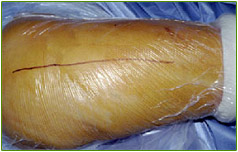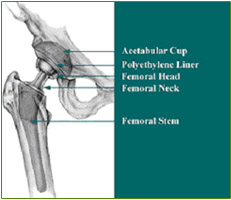|
| |
In total hip replacement surgery, the damaged ball and socket are removed and replaced with a new set that is made of metal and a durable plastic material. These artificial parts are called implants, or prostheses. There are three different types of prostheses: cemented, uncemented and custom. Based on your age, activity level, bone shape, size and strength, your orthopedic surgeon will decide which prostheses is best for you. This will be discussed with you at your pre-op visit.
You will be admitted to the hospital on the day of your scheduled surgery. You will be asked to arrive to the hospital two hours before the start of your surgery. After admission, you will move into the pre-operative area where you will be evaluated by an anesthesiologist. The most common type of anesthesia is general, in which you are given anesthesia through an intravenous (IV) drip that keeps you asleep for the entire surgery. Your anesthesiologist also may offer you an epidural or spinal injection or a combination of the above. You will discuss this with your anesthesiologist prior to your surgery.
The Surgical Procedure
After the anaesthesia is received, an incision is made down the side of your hip. The damaged ball is removed, and the socket is prepared to hold the prosthesis. Upon fitting the new joint in place, the incision is closed with staples and/or stitches. |
|
| |
|
 |
|
| |
|
 |
Preparing The Bone
The ball is cut from the femur and the surface of the old socket is smoothed. The new socket is put into the pelvis. The socket is usually press-fit but may be held in by screws or cement.
Joining the New Parts
The new hip stem is inserted into the head of your thighbone. After the stem is secure in the thighbone, the new ball and socket are joined. The stem of the prosthesis may be held with cement or press-fit. Your surgeon will choose which method is best for you. |
|
|